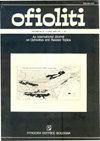外部含锂辉石地幔的斜长石相热气压演化(意大利苏韦罗)
IF 1.3
4区 地球科学
Q2 GEOLOGY
引用次数: 4
摘要
斜长石橄榄岩是伸展环境下岩石圈地幔浅层地球动力学演化的重要标志。基于低压实验,Fumagalli等人最近的一项研究(2017)基于Forsterite Anorthite Ca Tschermak Enstatite(FACE)压敏平衡,定义并校准了橄榄岩整体成分的地质气压计。FACE地质气压计在其上进行校准的含苏韦罗斜长石的橄榄岩主要与斜长石辉石岩有关。假设辉石岩记录的压力-温度演化与斜长石橄榄岩相同,它们是测试FACE地质气压计对辉石岩成分适用性的理想候选者。正如斜长石橄榄岩中所记载的那样,辉石岩的特征是细粒新变晶组合的发育,表明在斜长石相条件下存在部分再结晶。这些新变晶矿物聚集体中的化学分带表明在可变压力和温度下的平衡阶段,并允许记录两个重新平衡阶段,分别对应于斜长石相重结晶的开始(830-850°C,6.9-8.1±0.5 kbar)和较浅的较冷重新平衡(770-790°C,5.8-5.9±0.5 kbbar)。尽管在稍高的平衡压力(~1 kbar)下,辉石体成分的减压演化与相关Suvero橄榄岩中记录的剥露历史一致。值得注意的是,辉石岩中XCr低得多,反映了辉石中Cr含量低,因此,斜辉石中Ca Tschermak活性明显较高,这可能会导致FACE地质气压计对系统压力的高估。本文章由计算机程序翻译,如有差异,请以英文原文为准。
Plagioclase-facies thermobarometric evolution of the External Liguride pyroxenite-bearing mantle (Suvero, Italy)
Plagioclase peridotites are an important marker of the shallow geodynamic evolution of the lithospheric mantle at extensional settings. Based on lowpressure experiments, a recent study by Fumagalli et al. (2017) defined and calibrated a geobarometer for peridotitic bulk compositions, based on the Forsterite-Anorthite-Ca-Tschermak-Enstatite (FACE) pressure-sensitive equilibrium. The Suvero plagioclase-bearing peridotites, on which the FACE geobarometer was calibrated, are primarily associated to plagioclase pyroxenites. Assuming that the pyroxenites record the same Pressure-Temperature evolution than the plagioclase peridotites, they represent ideal candidates to test the applicability of the FACE geobarometer on pyroxenitic compositions. As documented in the plagioclase peridotites, the pyroxenites are characterized by the development of fine-grained neoblastic assemblages, indicative of partial recrystallization under plagioclase-facies conditions. Chemical zonations in these neoblastic mineral aggregates suggest equilibration stages at variable pressure and temperature and allowed to document two re-equilibration stages corresponding to the onset of plagioclase-facies recrystallization (830-850°C, 6.9-8.1±0.5 kbar) and a shallower colder re-equilibration (770-790°C, 5.8-5.9±0.5 kbar), respectively. The decompressional evolution reported for pyroxenitic bulk compositions is consistent with the exhumation history documented in the associated Suvero peridotite, although at slightly higher equilibrium pressures (~ 1 kbar). Remarkably, the much lower XCr in pyroxenites reflects in lower Cr incorporation in pyroxenes and, consequently, in significantly higher Ca-Tschermak activity in clinopyroxene that might introduce the systematic pressure overestimation by FACE geobarometer.
求助全文
通过发布文献求助,成功后即可免费获取论文全文。
去求助
来源期刊

Ofioliti
地学-地质学
CiteScore
2.40
自引率
7.70%
发文量
1
期刊介绍:
Since 1976, Ofioliti provides an international forum for original contributions and reviews in the field of the geodynamics, petrology, geochemistry, biostratigraphy, stratigraphy, tectonics and paleogeography applied to ophiolitic terrains and modern oceanic lithosphere, including their sedimentary cover. Studies of topics such as geodynamics of the mantle, the evolution of orogens including ophiolites and paleoceanography are also welcome
 求助内容:
求助内容: 应助结果提醒方式:
应助结果提醒方式:


